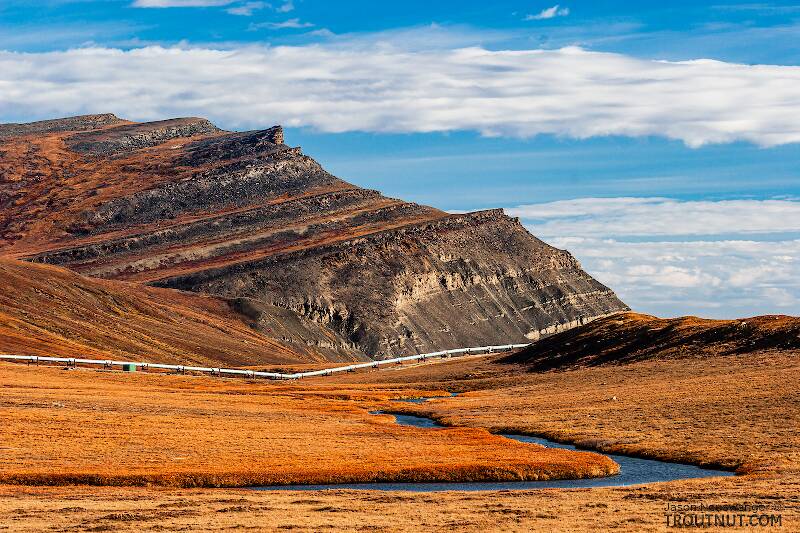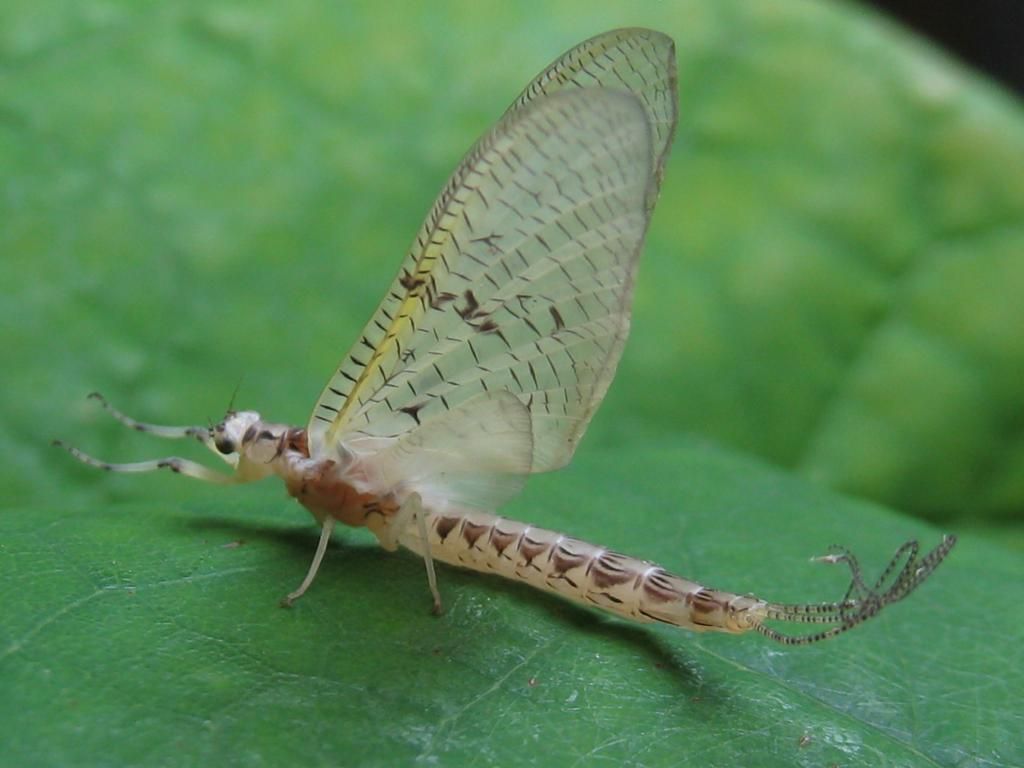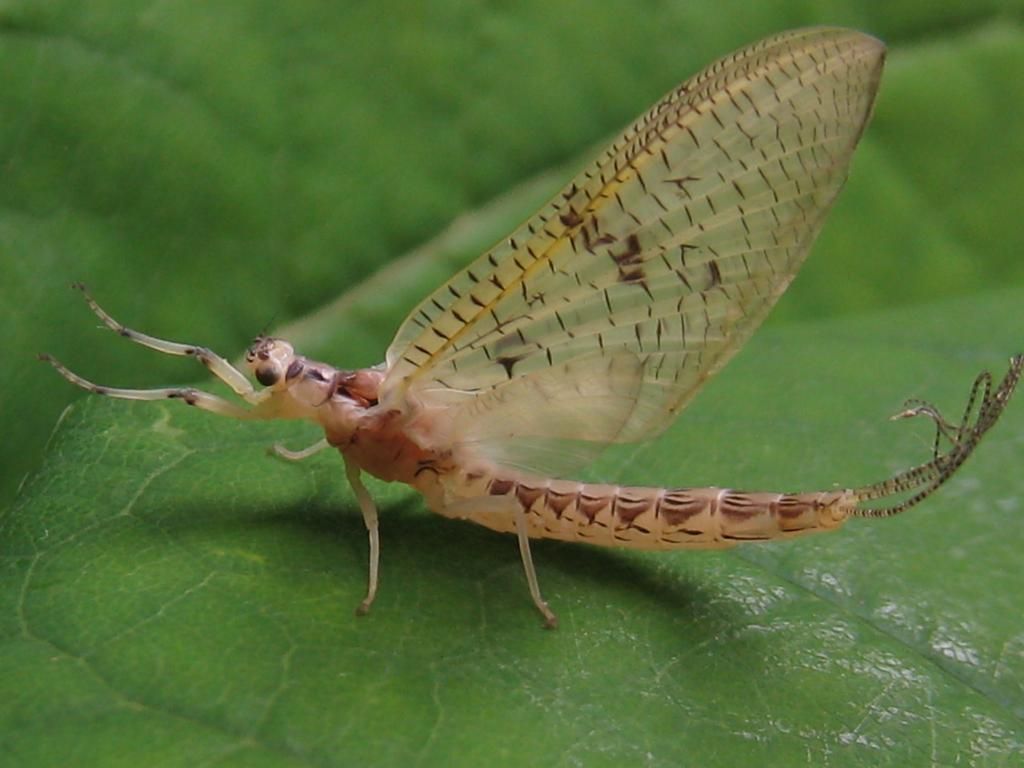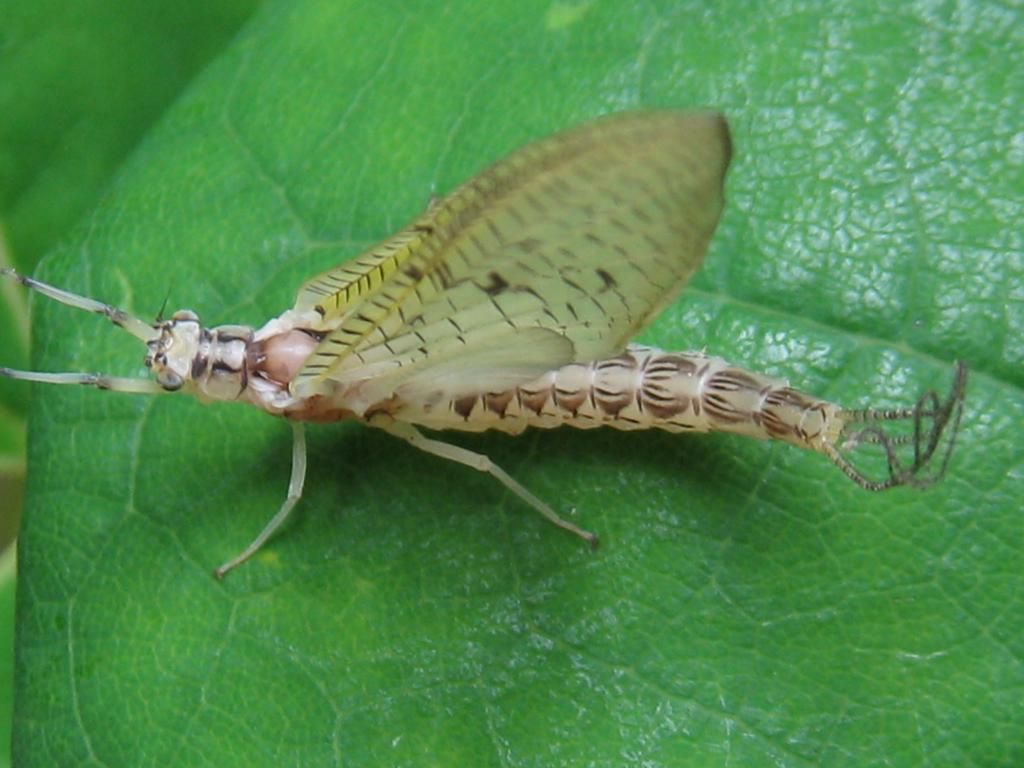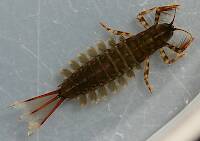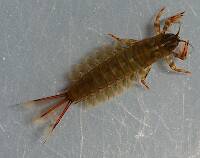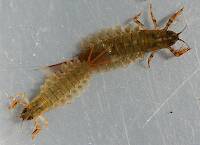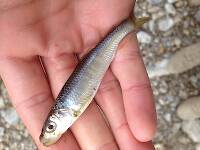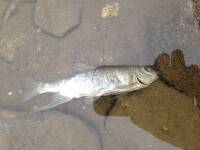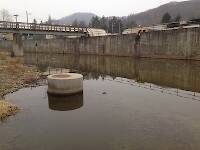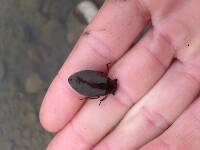
Hex Mayflies
Hexagenia limbata
The famous nocturnal Hex hatch of the Midwest (and a few other lucky locations) stirs to the surface mythically large brown trout that only touch streamers for the rest of the year.
Featured on the forum

Some characteristics from the microscope images for the tentative species id: The postero-lateral projections are found only on segment 9, not segment 8. Based on the key in Jacobus et al. (2014), it appears to key to Neoleptophlebia adoptiva or Neoleptophlebia heteronea, same as this specimen with pretty different abdominal markings. However, distinguishing between those calls for comparing the lengths of the second and third segment of the labial palp, and this one (like the other one) only seems to have two segments. So I'm stuck on them both. It's likely that the fact that they're immature nymphs stymies identification in some important way.

Troutnut is a project started in 2003 by salmonid ecologist Jason "Troutnut" Neuswanger to help anglers and
fly tyers unabashedly embrace the entomological side of the sport. Learn more about Troutnut or
support the project for an enhanced experience here.
Millcreek on Aug 2, 2014August 2nd, 2014, 11:45 am EDT
Eric -
Very nice photos. They certainly are elegant looking little creatures. Interesting that some of the nymphs seem to have similar markings on the dorsal abdomen.
Mark
Very nice photos. They certainly are elegant looking little creatures. Interesting that some of the nymphs seem to have similar markings on the dorsal abdomen.
Mark
"If we knew what it was we were doing, it would not be called research, would it?"
-Albert Einstein
-Albert Einstein
Lastchance on Aug 3, 2014August 3rd, 2014, 5:52 am EDT
What is the common name for the fly, Eric?
Crepuscular on Aug 3, 2014August 3rd, 2014, 8:35 am EDT
What is the common name for the fly, Eric?
yellow drake
Crepuscular on Aug 3, 2014August 3rd, 2014, 4:07 pm EDT
Eric -
Very nice photos. They certainly are elegant looking little creatures. Interesting that some of the nymphs seem to have similar markings on the dorsal abdomen.
Mark
Thanks Mark, in my experience many of the Ephemerids retain the dorsal abdominal patterns that they have as an immature insect into the adult stage. Funny thing is, the variability even within the same species, is great. And I've never read anything that explains that other than what might be chalked up to somewhat isolated population genetics.
Millcreek on Aug 4, 2014August 4th, 2014, 7:02 am EDT
Eric -
We also have a number of species on the west coast that exhibit a lot of variability in the same species, at least in the nymphs. Many Ephemerellidae nymphs show a high degree of variability in color patterns. Drunella flavilinea, Ephemerella dorothea, Attenella soquele and to a lesser degree Serratella species all show a lot of variability. In the Heptageniidae, Rhithrogena and Nixe show some color and patterning differences amongst the same species and in Leptophlebiidae, Paraleptophlebia helenae, one of the tusked Leptophlebia shows wide variation in the shape of the tusks. And don't get me started on Baetis. I'm sure a number of other mayfly species in the area also exhibit these traits but these are some of the ones I'm most familiar with.
I've found large degrees of patterning variability within very small geographic areas. Not sure what causes it, but possibly it's simply large numbers of an animal with a short development time accumulating genetic changes that work for it. Or not, who knows.
Funny thing is, the variability even within the same species, is great. And I've never read anything that explains that other than what might be chalked up to somewhat isolated population genetics.
We also have a number of species on the west coast that exhibit a lot of variability in the same species, at least in the nymphs. Many Ephemerellidae nymphs show a high degree of variability in color patterns. Drunella flavilinea, Ephemerella dorothea, Attenella soquele and to a lesser degree Serratella species all show a lot of variability. In the Heptageniidae, Rhithrogena and Nixe show some color and patterning differences amongst the same species and in Leptophlebiidae, Paraleptophlebia helenae, one of the tusked Leptophlebia shows wide variation in the shape of the tusks. And don't get me started on Baetis. I'm sure a number of other mayfly species in the area also exhibit these traits but these are some of the ones I'm most familiar with.
I've found large degrees of patterning variability within very small geographic areas. Not sure what causes it, but possibly it's simply large numbers of an animal with a short development time accumulating genetic changes that work for it. Or not, who knows.
"If we knew what it was we were doing, it would not be called research, would it?"
-Albert Einstein
-Albert Einstein
Crepuscular on Aug 4, 2014August 4th, 2014, 7:12 am EDT
We also have a number of species on the west coast that exhibit a lot of variability in the same species, at least in the nymphs. Many Ephemerellidae nymphs show a high degree of variability in color patterns.
Yes the empherellids seem to be the poster child for variabilty. I don't know if you have seen this old thread http://www.troutnut.com/topic/7887/More-Variation.
Millcreek on Aug 4, 2014August 4th, 2014, 7:47 am EDT
Interesting thread. Reminds me of Serratella micheneri over here. When the nymphs are present you can find a similar number of variations, often on a single large cobble. I'll have to see if I can hunt up enough photos to show some of the variation.
"If we knew what it was we were doing, it would not be called research, would it?"
-Albert Einstein
-Albert Einstein
Crepuscular on Aug 5, 2014August 5th, 2014, 11:39 am EDT
Looks like a sulfur to me.
:)
Jmd123 on Aug 5, 2014August 5th, 2014, 4:38 pm EDT
Eric, how about showing us some of the fishies that are currently munching on these? And yes I agree, they are quite beautiful and delicately colored creatures, especially illustrated by your very nice photos.
Jonathon
Jonathon
No matter how big the one you just caught is, there's always a bigger one out there somewhere...
Feathers5
Posts: 287
Posts: 287
Feathers5 on Aug 6, 2014August 6th, 2014, 4:51 am EDT
Eric, how about showing us some of the fishies that are currently munching on these? And yes I agree, they are quite beautiful and delicately colored creatures, especially illustrated by your very nice photos.
Jonathon
Well, now we have a problem. :)
Crepuscular on Aug 6, 2014August 6th, 2014, 7:27 am EDT
Jmd123 on Aug 6, 2014August 6th, 2014, 8:43 am EDT
Why, that fly looks to be about 12/0 - what weight rod do you throw those on, Eric?
;oD
Jonathon
;oD
Jonathon
No matter how big the one you just caught is, there's always a bigger one out there somewhere...
Entoman on Aug 6, 2014August 6th, 2014, 9:07 am EDT
He already mentioned his preference for a 3 wt, Jon. Thats right up your alley.
Yes, I've heard that Great Whites selectively feed on mayflies when in fresh water. Never seen it documented before, though. Excellent photo, Eric. You caught the subtle rise form with perfect timing. BTW - Did you encourage Bruce to wade in close for a good presentation? They're supposed to be easy to put down unless the drift is flawless and directly in their feeding lane.
Yes, I've heard that Great Whites selectively feed on mayflies when in fresh water. Never seen it documented before, though. Excellent photo, Eric. You caught the subtle rise form with perfect timing. BTW - Did you encourage Bruce to wade in close for a good presentation? They're supposed to be easy to put down unless the drift is flawless and directly in their feeding lane.
"It's not that I find fishing so important, it's just that I find all other endeavors of Man equally unimportant... And not nearly as much fun!" Robert Traver, Anatomy of a Fisherman
Crepuscular on Aug 6, 2014August 6th, 2014, 9:13 am EDT
BTW - Did you encourage Bruce to wade in close for a good presentation? They're supposed to be easy to put down unless the drift is flawless and directly in their feeding lane.
I was using Bruce as a teaser. Kinda like a hookless plug that I would pull away and then put the comparadun in front of the fish. They were suckers for it. But it requires a drownstream presentation.
Entoman on Aug 6, 2014August 6th, 2014, 9:14 am EDT
LOL:)
"It's not that I find fishing so important, it's just that I find all other endeavors of Man equally unimportant... And not nearly as much fun!" Robert Traver, Anatomy of a Fisherman
Entoman on Aug 6, 2014August 6th, 2014, 9:21 am EDT
Yes, I've heard that he likes to dive under for a quick survey of the available fauna before casting. Does that help in marking the locations of these elusive free risers?
"It's not that I find fishing so important, it's just that I find all other endeavors of Man equally unimportant... And not nearly as much fun!" Robert Traver, Anatomy of a Fisherman
Crepuscular on Aug 6, 2014August 6th, 2014, 9:24 am EDT
Yes, I've heard that he likes to dive under for a quick survey of the available fauna before casting. Does that help in marking the locations of these elusive free risers?
Exactly, that where I got the idea.
Crepuscular on Aug 6, 2014August 6th, 2014, 9:27 am EDT
He already mentioned his preference for a 3 wt, Jon. Thats right up your alley.
I don't think so, they wouldn't eat a White Wulff ;)
Quick Reply
Related Discussions
Topic
Replies
Last Reply
6
Apr 14, 2013
by Troutnut
by Troutnut
5
Jun 8, 2006
by Wiflyfisher
by Wiflyfisher
0
May 28, 2012
by Shawnny3
by Shawnny3

